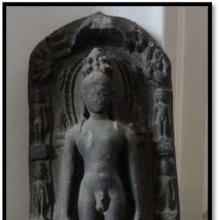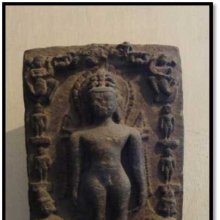Jatajuta, Jaṭājūṭa: 12 definitions
Introduction:
Jatajuta means something in Hinduism, Sanskrit, Marathi. If you want to know the exact meaning, history, etymology or English translation of this term then check out the descriptions on this page. Add your comment or reference to a book if you want to contribute to this summary article.
Images (photo gallery)
In Hinduism
Shaktism (Shakta philosophy)
Source: Google Books: ManthanabhairavatantramJaṭājūṭa (जटाजूट) refers to “matted hair” and is used to describe Śaṃkara (i.e., Bhairava), according to the second recension of the Yogakhaṇḍa of the Manthānabhairavatantra, a vast sprawling work that belongs to a corpus of Tantric texts concerned with the worship of the goddess Kubjikā.—Accordingly, as the Goddess (i.e., Khageśī) said to the God (i.e., Bhairava), “[...] Give up the ash, the matted hair [i.e., jaṭājūṭa] and the form with five faces. Give up the bones and skull and (all) else that is artificial. Give up (the practice of ritual) gestures, the Moon and the sacred thread. Give up the bull and the Ganges. Give up (your) spear and the great serpent, the ascetic's staff and, O god, the garland of severed heads and the skull. Accomplishment (siddhi) (can only be found) in Kula, Kaula and the Western (transmission) of Sadyojāta. [...]”.

Shakta (शाक्त, śākta) or Shaktism (śāktism) represents a tradition of Hinduism where the Goddess (Devi) is revered and worshipped. Shakta literature includes a range of scriptures, including various Agamas and Tantras, although its roots may be traced back to the Vedas.
Shaivism (Shaiva philosophy)
Source: Google Books: Manthanabhairavatantram (shaivism)Jaṭājūṭa (जटाजूट) refers to “one who has beautiful matted hair” and is used to describe Svacchanda, according to the Śrīmatottara-tantra, an expansion of the Kubjikāmatatantra: the earliest popular and most authoritative Tantra of the Kubjikā cult. Accordingly, “O goddess, Svacchanda is in the middle, within the abode of the triangle. Very powerful, he has five faces with three times five flaming eyes. He has ten arms and, very fierce, is adorned with many garlands, ornaments, necklaces and anklets. He has beautiful matted hair [i.e., jaṭājūṭa-dhara] and the half moon is his crest jewel. O beloved, the face in the east is white like cow’s milk, it shines brilliant white. Generating great energy, contemplate it thus. One should think that the northern face is like the young rising sun, the form of a pomegranate flower and (red) like a Bandhūka”.

Shaiva (शैव, śaiva) or Shaivism (śaivism) represents a tradition of Hinduism worshiping Shiva as the supreme being. Closely related to Shaktism, Shaiva literature includes a range of scriptures, including Tantras, while the root of this tradition may be traced back to the ancient Vedas.
Purana and Itihasa (epic history)
Source: archive.org: Shiva Purana - English TranslationJaṭājūṭa (जटाजूट) refers to the “matted hair” of Śiva, according to the Śivapurāṇa 2.3.27 (“Description of the fraudulent words of the Brahmacārin”).—Accordingly, as Śiva (in guise of a Brahmacārin) said to Pārvatī: “[...] Leaving off the guardians of the quarters you run after Śiva. This is not well said. It is against the conventions of the world. Where you with eyes like the petals of a lotus? Where this three-eyed creature—Śiva? You are moon-faced while Śiva is five-faced. On your head the divine plaited hair shines with glossy splendour like a serpent. But Śiva has only the matted hair [i.e., jaṭājūṭa] to boast of? [...]”.

The Purana (पुराण, purāṇas) refers to Sanskrit literature preserving ancient India’s vast cultural history, including historical legends, religious ceremonies, various arts and sciences. The eighteen mahapuranas total over 400,000 shlokas (metrical couplets) and date to at least several centuries BCE.
Languages of India and abroad
Marathi-English dictionary
Source: DDSA: The Molesworth Marathi and English Dictionaryjaṭājūṭa (जटाजूट).—m (jaṭā & juṭaṇēṃ) The tuft on the heads of gōsāvī &c. formed of the clotted and matted locks.
Source: DDSA: The Aryabhusan school dictionary, Marathi-Englishjaṭājūṭa (जटाजूट).—m The tuft on the heads of gōsāvī &c. formed of the clotted and mat- ted locks.
Marathi is an Indo-European language having over 70 million native speakers people in (predominantly) Maharashtra India. Marathi, like many other Indo-Aryan languages, evolved from early forms of Prakrit, which itself is a subset of Sanskrit, one of the most ancient languages of the world.
Sanskrit dictionary
Source: Cologne Digital Sanskrit Dictionaries: Shabda-Sagara Sanskrit-English DictionaryJaṭājūṭa (जटाजूट).—m.
(-ṭaḥ) 1. A quantity of clotted hair. 2. Siva'S hair. E. jaṭā, and jūṭa the same. jaṭānāṃ jūṭaḥ bandhaḥ .
Source: Cologne Digital Sanskrit Dictionaries: Cappeller Sanskrit-English DictionaryJaṭājūṭa (जटाजूट).—[masculine] = jaṭākalāpa.
Source: Cologne Digital Sanskrit Dictionaries: Monier-Williams Sanskrit-English DictionaryJaṭājūṭa (जटाजूट):—[=jaṭā-jūṭa] [from jaṭā > jaṭa] m. the long tresses of hair twisted on the top of the head, quantity of twisted hair (also applied to that of Śiva, [Kathāsaritsāgara i, 18]), [Bhāgavata-purāṇa v, 17, 3; Mahānāṭaka; Kathāsaritsāgara] etc. (ifc. f(ā). , [Hemādri’s Caturvarga-cintāmaṇi])
Source: Cologne Digital Sanskrit Dictionaries: Yates Sanskrit-English DictionaryJaṭājūṭa (जटाजूट):—[jaṭā-jūṭa] (ṭaḥ) 1. m. Much clotted hair.
[Sanskrit to German]
Sanskrit, also spelled संस्कृतम् (saṃskṛtam), is an ancient language of India commonly seen as the grandmother of the Indo-European language family (even English!). Closely allied with Prakrit and Pali, Sanskrit is more exhaustive in both grammar and terms and has the most extensive collection of literature in the world, greatly surpassing its sister-languages Greek and Latin.
Kannada-English dictionary
Source: Alar: Kannada-English corpusJaṭājūṭa (ಜಟಾಜೂಟ):—[noun] long, matted hair of the head.
Kannada is a Dravidian language (as opposed to the Indo-European language family) mainly spoken in the southwestern region of India.
See also (Relevant definitions)
Full-text: Juta, Jatabhara, Dradhay, Parivridha, Indubhushita, Ardhacandrika, Mauli, Pinga, Babhru.
Relevant text
Search found 3 books and stories containing Jatajuta, Jaṭājūṭa, Jata-juta, Jaṭā-jūṭa; (plurals include: Jatajutas, Jaṭājūṭas, jutas, jūṭas). You can also click to the full overview containing English textual excerpts. Below are direct links for the most relevant articles:
Sahitya-kaumudi by Baladeva Vidyabhushana (by Gaurapada Dāsa)
Text 10.162 < [Chapter 10 - Ornaments of Meaning]
Sripura (Archaeological Survey) (by Bikash Chandra Pradhan)
Copper Images < [Chapter 3 - Sculptural Programme]
Jain Remains of Ancient Bengal (by Shubha Majumder)
Jain Aṣṭāpadatīrtha Sculptures < [Chapter 6 - Iconographic Study of Jaina Sculptural Remains]
Caubisi type of Ṛṣabhanātha sculptures < [Chapter 6 - Iconographic Study of Jaina Sculptural Remains]

